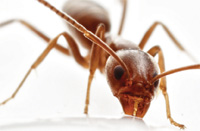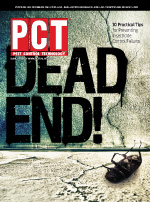Editor’s Note: The following article was adapted from Techletter, a biweekly publication from Pinto & Associates, Mechanicsville, Md. To subscribe, visit www.techletter.com or call 301/884-3020.
The tiny, black, notorious Argentine ant is established in the southern United States, California and Hawaii. Less widespread infestations are also found in Arizona, Illinois, Indiana, Missouri, Maryland, Oregon and Washington.
 Argentine ants are especially difficult to control because they have an unusual biology. Unlike many other ant species, they have many queens, and workers can go back to any nest, essentially forming one large supercolony, often linked by tunnels. In most cases, there will be multiple outdoor nests that are difficult to locate. Finding and destroying the nests directly can be difficult, so using baits to kill the colony is a more viable control option.
Argentine ants are especially difficult to control because they have an unusual biology. Unlike many other ant species, they have many queens, and workers can go back to any nest, essentially forming one large supercolony, often linked by tunnels. In most cases, there will be multiple outdoor nests that are difficult to locate. Finding and destroying the nests directly can be difficult, so using baits to kill the colony is a more viable control option.
Which Bait? In most areas, fall is the best time to bait for Argentine ants because their outside honeydew food sources are disappearing, and they are looking for new supplies of food. Argentine ants will switch back and forth between a preference for sugar or protein baits, but liquid sugar baits (with an optimum concentration of 25 percent sugar) are readily taken by workers year round and fed to others in the nest. Protein-based baits seem to work best in spring and early summer. Granular baits must have a small particle size (840 to 1,000 micrometers) to be accepted.
Boric acid, borax or borate baits often are used for Argentine ants. The concentration of borate active ingredient that will work to kill the colony is between 0.5 and 2 percent. Lesser amounts of active ingredient (AI) may have no effect, while using too much AI in the bait can repel the ants or kill them before they can carry bait back to feed the colony. Higher concentrations of AI can be used for quick knockdown of trailing ants, especially indoors, but will likely not achieve long-term control of the colony. Consequently, baits must be low concentration and slow-acting in order to be effective at killing the colony. Boric acid baits may need to be available for several weeks to be most effective. Other delayed toxicity baits contain the active ingredients abamectin, fipronil, thiamethoxam or indoxacarb.
How to Apply Bait. Use bait stations that hold granular or liquid bait — or both. Bait stations protect the bait and non-target animals. Use pre-baited ant stations or select bait stations with at least a 200-ml liquid capacity (500 ml is better). Granular baits also should be placed in bait stations since research has shown no advantage when granules are broadcast instead. Gels also can be placed inside bait stations or into cracks and crevices (but check the label).
A. Indoor Placement: If you are using a bait to achieve quick kill indoors, place the baits or bait stations in out-of-the-way places but on ant trails when possible. Keep bait stations away from areas that have been sprayed with pesticide.
B. Outdoor Placement: To achieve colony kill with borate baits, it is best to place your lower AI bait outside the structure so as not to continuously attract ants inside during the extended baiting period. Outside, use four stations for a one-acre lot and two additional stations for each additional acre. Place the stations where ants are seen trailing and near moisture sources. Don’t place bait stations in the sun since evaporation of liquid bait could concentrate the bait to the point where it is too concentrated to be effective in killing the colony. Do not spray bait stations with pesticide nor place them near previously sprayed areas.
Gel baits can be applied in bait stations or into cracks and crevices and on vertical surfaces but in areas where the bait is protected from weather and not accessible to people, children or animals.
|
Advice for Your Customer on Indoor Ant Control
|
The authors are well-known industry consultants and owners of Pinto & Associates, Mechanicsville, Md.

Explore the March 2012 Issue
Check out more from this issue and find your next story to read.
Latest from Pest Control Technology
- SiteOne Hosts 2024 Women in Green Industry Conference
- Veseris Celebrates Grand Reopening of the Miami ProCenter
- Rollins' 2024 Second Quarters Revenues up 8.7 Percent YOY
- Fleetio Go Fleet Maintenance App Now Available in Spanish
- German Cockroach Control Mythbusting
- Total Pest Control Acquires Target Pest Control
- NPMA Workforce Development Shares Hiring Updates
- Certus Acquires Jarrod's Pest Control
 Ants found indoors may be nesting in the structure itself, or they may just be coming indoors looking for food or water. Whatever the case, there are certain steps your customer can take that will help with indoor ant control:
Ants found indoors may be nesting in the structure itself, or they may just be coming indoors looking for food or water. Whatever the case, there are certain steps your customer can take that will help with indoor ant control:




